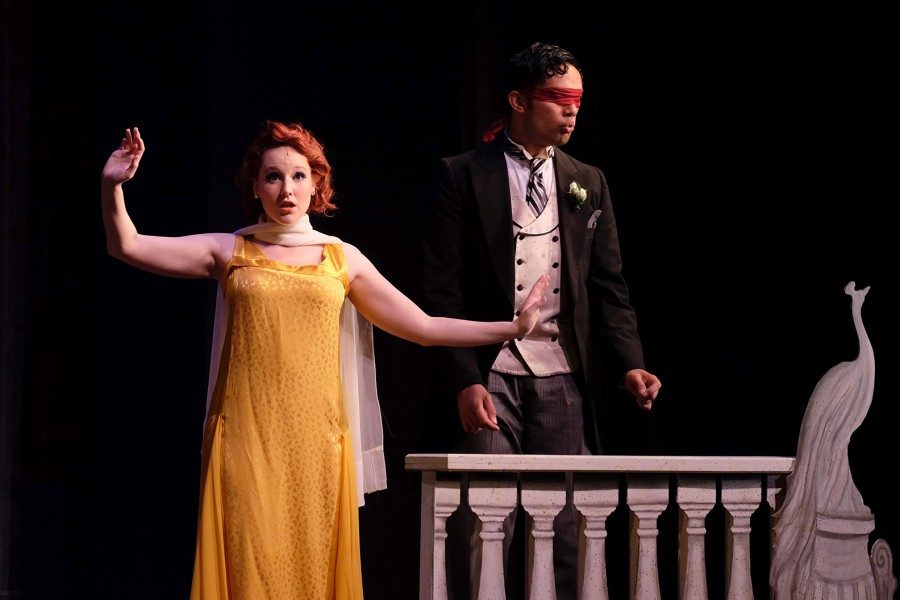San Diego State theater graduate student Caroline Andrew is a light designer for various theatrical productions, art projects and music shows.
This means she is in charge of how a set or stage will look under the lights and how the colors and light placement should illustrate what is going on in the production.
She works on various projects on campus as well as around San Diego.
Most recently, she was involved with the on-campus production of “Julius Caesar,” which was open last week.
Before that, Andrew was a lighting intern at Kaaboo Del Mar.
She is also currently assisting a local lighting designer on a show called “Bad Jews” at the Cygnet Theater.
Next semester she will be working as a lighting intern at the Los Angeles Opera.
Andrew’s journey in theater technology began in high school and has only grow from there.
“It all got started because the boys told me I couldn’t, that’s genuinely it,” she said. “I had done almost every other sort of type of theater technology at that point. I was really interested in the light board and I asked if I could try it out and they said no, because I would ‘break everything.’”
In her efforts to prove the boys wrong, Andrew came to realize that she loved lighting as the “perfect mix of electrical technology and art.”
In the theater department, the lighting techs fulfill all roles, such as basic and master electrician, various assistants, programmer and designer.
The room for creativity combined with a sense of pressure is one of Andrew’s favorite parts about the job.
Lighting design is typically done on the spot, usually even in front of the director and other people.
“There are moments that need to be specific to different moods and what’s going on with the music and the choreography,” musical theatre professor Stephen Brotebeck said. “From the beginning, Caroline was a great influence with that and using color to set mood for directions and choreography.”
Brotebeck directs and choreographs all of the on-campus musicals after leaving Broadway.
He worked with Andrew last year on “The Drowsy Chaperone,“ where she was the lighting designer.
He said when he starts to work on the choreography of a musical, he thinks about the story and what sort of world that story takes place in before developing characters’ behaviors and movements.
After reading a play three to five times and going to design meetings to determine what the production’s world will be like, Andrew works on how the lights will illustrate mood and location. These needs are then translated into equipment, which is then put into the air where “the fun begins.”
Once the equipment is in the air, creativity can take over as the designer messes around with the lights and how they feel in relation to what’s going on onstage.
Some of the design aspects are predetermined before the lights are set up in the air, but there is a sense of “visceral creativity” that surrounds the job once it’s more hands-on.
“Musical numbers have natural build to them and Caroline was able to replicate that build through her lighting,” Brotebeck said. “The best theatre isn’t when someone walks away saying ‘Oh wow, the set design was so good’ or ‘the lighting was so good.’ The best theatre happens when people walk away saying ‘Oh my goodness that was such a good show, everything worked so well together.”
“A great man always told me that his favorite project is the next one and I entirely subscribe to that,” Andrews said. “Each project I’ve done has been great for different reasons. I’ve done terrible shows that still fulfilled me emotionally, I’ve done great shows that made me feel like crap. It’s all about the experience and what the audience gets out of it.”
One of Andrew’s overarching goals is to break into the “boys club” that is theater technology.
Even though a woman, Jean Rosenthal, pioneered the field of theatrical lighting, it is largely dominated by men today.
Research from lighting designer Porsche McGovern spotlighted the distribution of jobs within the League of Resident Theatres.
The League is the largest professional association of theatres in the United States.
This research shows that in 2015 women filled only 13.7 percent of lighting design positions, while men held 86.3 percent.
The numbers are similar in sound design, where men hold 91.2 percent of the positions.
“I want to see how far I can get and I want to see how awesome I can be,” Andrew said. “And I want to save the world from bad lighting.”
Andrew will also be the lighting programmer for the School of Television, Theatre and Film’s production of “Jesus Christ Superstar in Concert” on Dec. 1 through 4.












